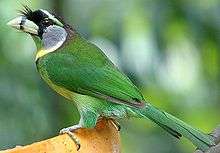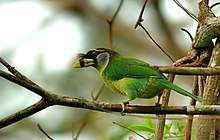Fire-tufted barbet
The fire-tufted barbet (Psilopogon pyrolophus) is a species of bird in the Asian barbet family Megalaimidae. It is native to Peninsular Malaysia and Sumatra, where it inhabits tropical moist lowland and montane forests. It has been listed as Least Concern on the IUCN Red List since 2004.[1] Its scientific name was proposed by Salomon Müller in 1836, who described a barbet from Sumatra.[2]
| Fire-tufted barbet | |
|---|---|
 | |
| Scientific classification | |
| Kingdom: | Animalia |
| Phylum: | Chordata |
| Class: | Aves |
| Order: | Piciformes |
| Family: | Megalaimidae |
| Genus: | Psilopogon |
| Species: | P. pyrolophus |
| Binomial name | |
| Psilopogon pyrolophus S. Müller, 1836 | |
Description

The moderately large bird (28 cm), the adult birds are overall green in appearance and have a brownish-maroon nape, grey lores, white band on the forehead, throat green, followed by a bright yellow band before a black band, appearing like a necklace separates the belly. The bill is fawn colored with a black vertical band. Tufts of feathers at the base of beak. Upper tufts fiery orange in males.[3]
Distribution and habitat
The fire-tufted barbet inhabits broad-leaved evergreen montane forests between 1,070 and 2,010 m (3,510 and 6,590 ft) on the Malay Peninsula and Sumatra.[3]
Behaviour and ecology
The fire-tufted barbet is a resident bird and feeds on figs, other fruits, arthropods and insects. Its call is very similar to that of cicadas.[4]
Threats
The primary threat to this species appears to be illegal capture and trade as a pet.[5]
References
- BirdLife International (2016). "Psilopogon pyrolophus". The IUCN Red List of Threatened Species. IUCN. 2016: e.T22681588A92912144. doi:10.2305/IUCN.UK.2016-3.RLTS.T22681588A92912144.en.
- Müller, S. (1835). "Aanteekeningen over de natuurlijke gesteldheid van een gedeelte der westkust en binnenlanden van Sumatra, met bijvoeging van eenige waarnemingen en beschrijvingen van verscheid dieren". Tijdschrift voor natuurlijke geschiedenis en physiologie. 2: 315–355.
- Robson, C. (2000). A guide to the birds of Southeast Asia: Thailand, Peninsular Malaysia, Singapore, Myanmar, Laos, Vietnam and Cambodia. Princeton University Press.
- del Hoyo, J.; Collar, N. J.; Kirwan, G. M. (2014). "Fire-tufted Barbet Psilopogon pyrolophus". In del Hoyo, J.; Elliott, A.; Sargatal, J.; Christie, D.A.; de Juana, E. (eds.). Handbook of the Birds of the World and BirdLife International Illustrated Checklist of the Birds of the World. Volume 7: Jacamars to Woodpeckers. Barcelona, Spain and Cambridge, UK: Lynx Edicions and BirdLife International.
- Shepherd, C. (2006). "The bird trade in Medan, north Sumatra: an overview" (PDF). Birding Asia. 5: 16–24.
External links
| Wikimedia Commons has media related to Psilopogon pyrolophus. |
| Wikispecies has information related to Psilopogon pyrolophus |
- BirdLife International (2019). "Fire-tufted Barbet Psilopogon pyrolophus".
